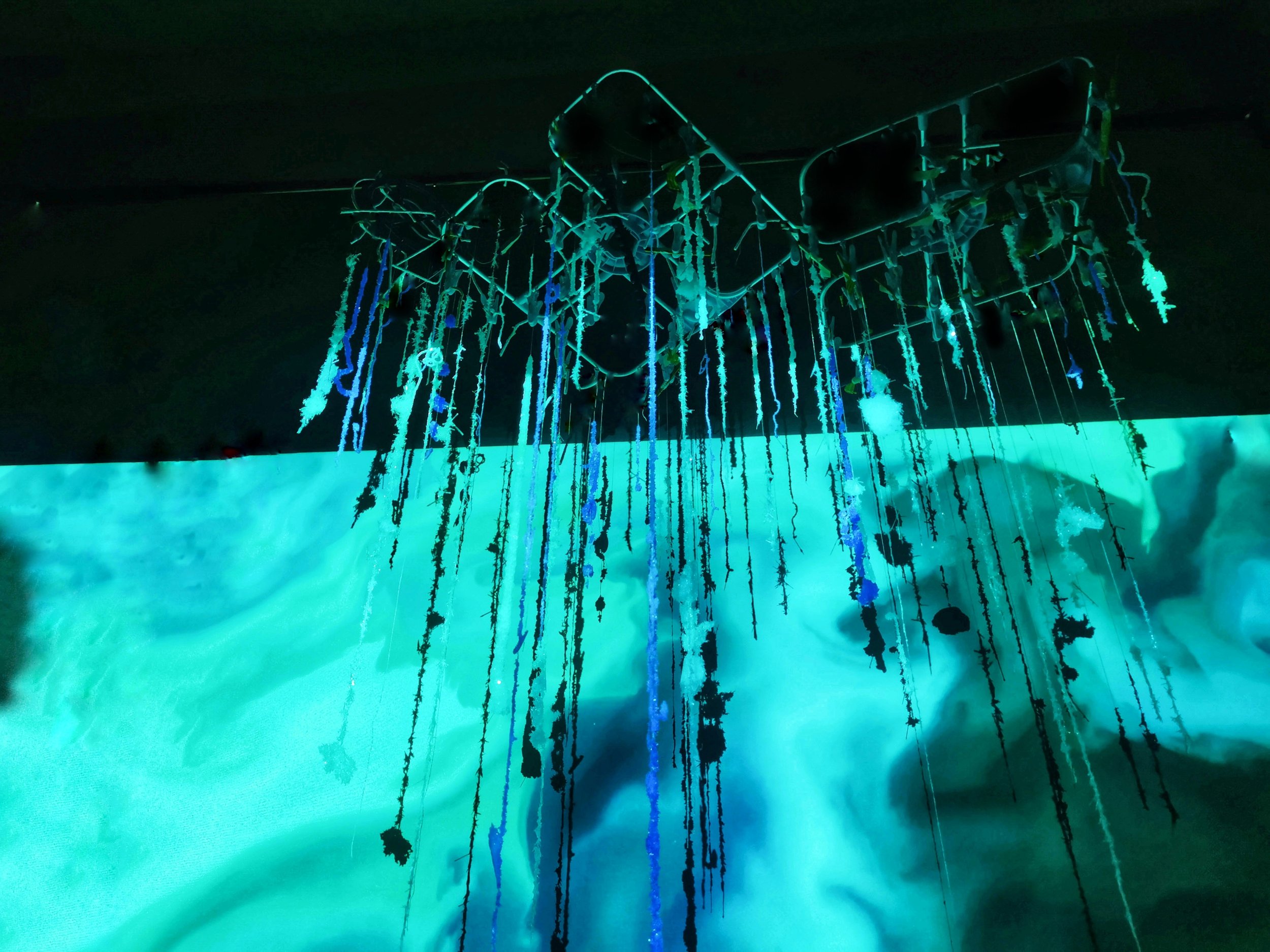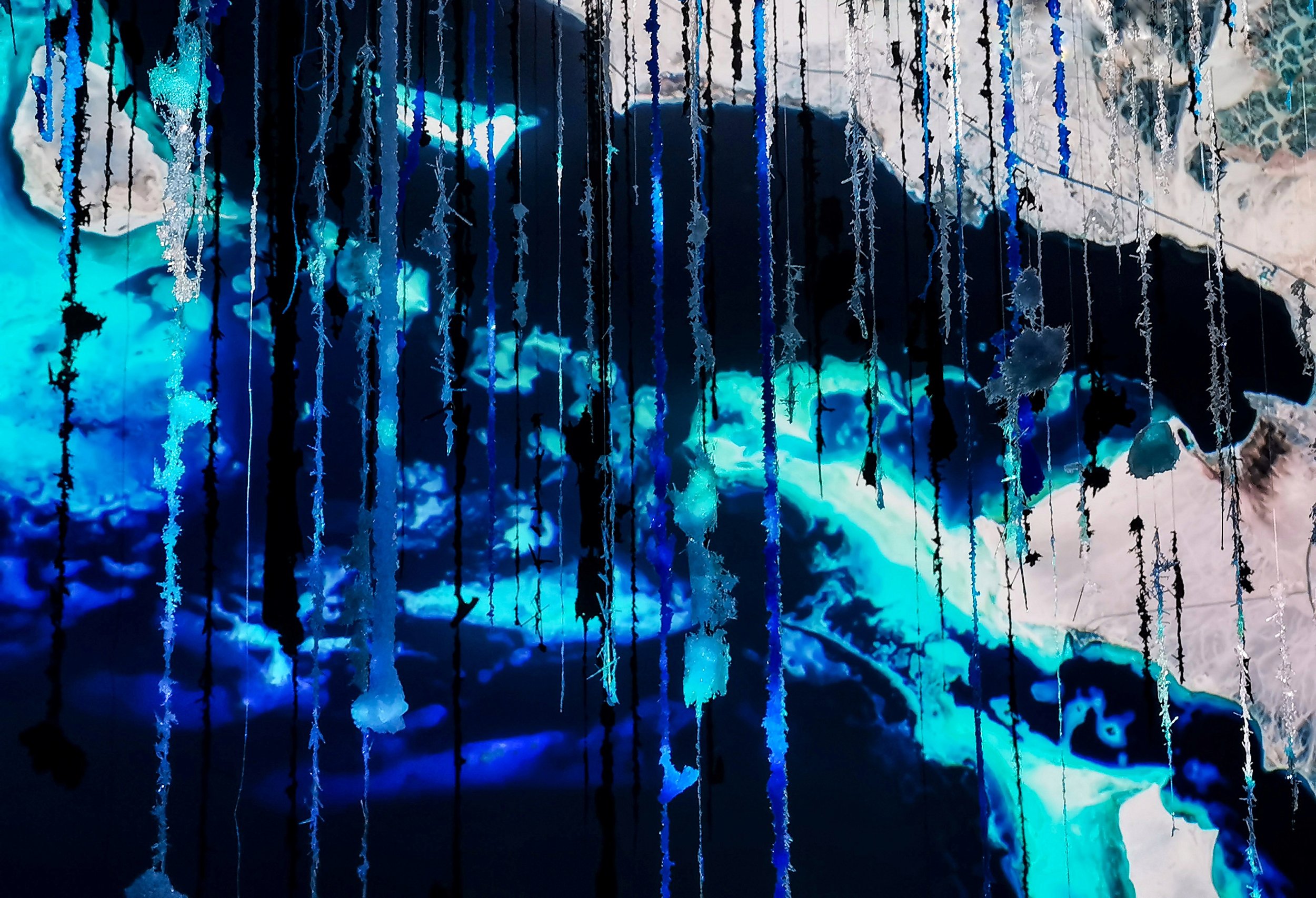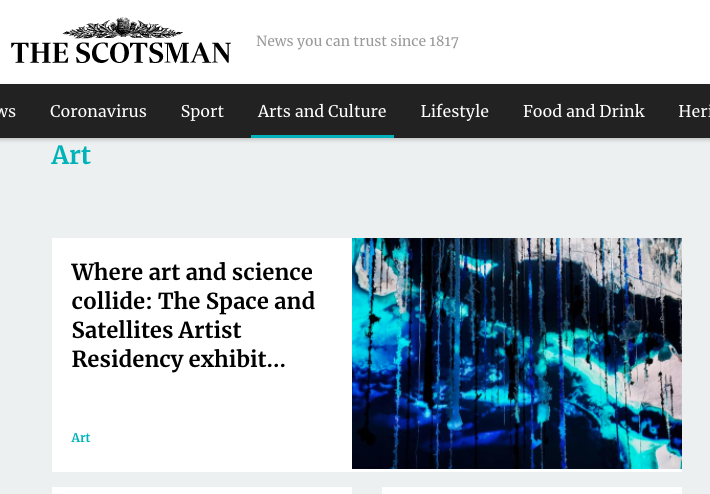Saltworks. Space and Satellite Artist Residency in collaboration with Royal Society for the Protection of Birds
Inspace Gallery, Edinburgh, Scotland, UK. 2020 - 2022
Installation. Salt, Wire, Copper Sulphite, Thread, Data visualisation,
Creative Process
Captivated by the complex biological and physical phenomenon of the natural world and a feeling of vastness when seeing the open ocean, I experiment with data visualisations and installation to inform and create new layers of interpretation by growing salt crystals to draw in space. Saltworks reflects the fragility and changing chemistry of our ocean ecosystems. Using puffin movement and ocean data, I explore impermanence and the interconnections of our living planet.
I was struck by how connected to the ocean puffins are: they spend most of their lives at sea, and only return to land to breed. They have the ability to navigate vast distances and are able to return to their exact birthplace after years of being in the open seas.
Realising puffins’ connection with – and awareness of – their environment, I studied the interconnections between bird life and the ocean.
I became fascinated with the sensuous aspects of the ocean, what we as humans can’t sense that other animals can. I explored the idea of mental maps: water having memory, layers, communication and vibration of the sea floor.
I developed a method to create art with the ocean, using salt as my medium - a material that originates from the earth, is essential for life, and reflects the fragility of our ocean ecosystems. By harnessing natural processes, I investigated how to create art through salt formation—accelerating, modifying, and manipulating the growth of salt from the ocean (film below showing salt crystals created during experimentation and build.)
Saltworks: Memory. Growth. Erosion.
Salt growth and crystals created during experimentation and build. Salt water collected from different locations.
Multiple experiments revealed the dominance of repeating patterns in the salt crystal formations, which evoke a sense of topography. The crystal structures resemble the building of matter, minerals, and layers of sediment over time, symbolising notions of memory, time, and transformation. Seabird and ocean movement data are projected as light, illuminating the intricate shapes and textures of the saltworks

Visualisation of the movement of puffins recorded from space, enabled by GPS tags placed by RSPB Project Puffin. Data collected from 4 colonies in northern Scotland: Fair Isle, Shiants, Hermaness and Foula.
Data collected from four puffin colonies in the north of Scotland:
Fair Isle
Shiants
Hermaness
Foula
Intrigued by satellite technology’s role in wildlife conservation, I collaborated with the Royal Society for the Protection of Birds (RSPB) on their Project Puffin. This initiative uses Global Positioning System (GPS) technology to track the movement of puffins, now a ‘Red’ listed endangered species, whose populations are declining, with climate change as a major factor. Small GPS tags are placed on these birds to record their location and movement as they feed, swim, hunt, and fly over the sea during their breeding season.
These visualized Project Puffin data reveal the incredible journeys undertaken by puffins. Each point represents an individual bird at a specific location in the north of Scotland, with colors denoting different puffin colonies.
Puffins serve as indicators of ocean health, acting as environmental sensors. They spend most of their lives at sea, diving up to 200 feet and remaining active day and night. One puffin, in this data, was tracked traveling 400 km to bring back food for its pufflings, (puffin chicks). Many puffins must travel vast distances in search of sandeels, their main food source. The decline of sandeel populations due to climate change and over-fishing is devastating seabird populations.
Pathways in Ocean Life
Saltworks. Inspace Gallery, Edinburgh, Scotland, UK.
Salts, copper sulphate, water, thread, wire, light projection of film of the sea in Ullapool, Scotland.
Data Visualisation: Bathymetric data and Sentinel-2 Earth Observation data with puffin movement patterns.
Height 6ft. Width 4ft. Length 6ft.
The installation uses the geospatial position of the puffins - white and blue crystals to represent day and night, with the length of each crystal corresponding to the ocean depth at that location and time.
Salt Immersion
Saltworks, Inspace Gallery, Edinburgh, Scotland, UK.
Salt Immersion. Salts crystals, copper, puffin movement in time as light.
Height 6ft. Width 4ft. Length 6ft.










Work in Progress Talk Part of the Inspace Space and Satellites Artist Residency programme, introduced by Dave Murray-Rust. Funded by DDI and supported by Edinburgh Futures Institute.
Saltworks: Interconnection and Fragility
Saltworks delves into the intricate interconnections of life within the ocean and the fragile state of our ecosystems. By growing salt crystals, I reflect the delicate balance of our ocean ecosystems and the interdependence of all life forms. This work invites viewers to reflect on the fragility of our natural world and the vital connections we share with every plant and animal. We all need and rely on each other to survive.




